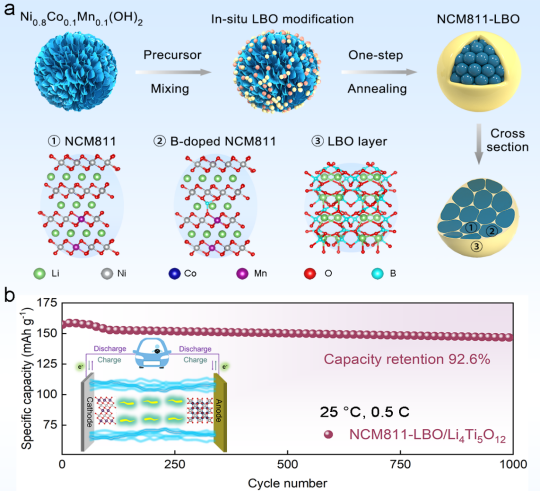Recently, the research group of Prof. Ying Bai from the School of Physics and Electronics has made new progress in the study of the modification on Ni-rich materials for the advanced lithium-ion battery. The related paper entitled with In-situ Construction of Gradient Oxygen Release Buffer and Interface Cation Self-Accelerator Stabilizing High-Voltage Ni-rich Cathode has been published in the journal of Advanced Functional Materials (https://doi.org/10.1002/adfm.202206428). The postgraduate Zhongsheng Dai is the first author, Dr. Huiling Zhao and Prof. Ying Bai are the corresponding authors.

Figure 1. (a) Schematic diagram for the preparation of in-situ LBO modified Ni-rich cathode and the corresponding structure of as-prepared samples. (b) Electrochemical performance for the as-assembled NCM811-LBO/LTO full cell.
Ni-rich cathodes with superior energy densities have spurred extensive attention for lithium-ion batteries (LIBs), whereas their commercialization is hampered by structural degradation, thermal runaway and dramatic capacity fading. Herein, boron (B) with high binding energy to oxygen (O) is gradiently incorporated into each primary particle, and piezoelectric Li2B4O7 (LBO) is homogeneously deposited on the secondary particles of polycrystalline LiNi0.8Co0.1Mn0.1O2 (NCM811) surface through a facile in-situ construction strategy, intending to synchronously enhance electrochemical stabilities and Li+ kinetics upon cycling. Particularly, the as-obtained LBO modified NCM811 cathode exhibits an excellent capacity retention (88.9% after 300 cycles, 1 C) and rate performance (112.2 mAh g−1, 10 C) with Li metal anode, the NCM811-LBO/Li4Ti5O12 full cell achieves a capacity retention of 92.6% after 1000 cycles (0.5 C). Intensive explorations in theoretical calculation, multi-scale in/ex-situ characterization and finite element analysis ascertain that the improvement mechanism of LBO modification can be attributed to the synergistic contributions of rational designed O release buffer and interface cation self-accelerator.
The synchronous modification of gradient B-incorporation and uniform piezoelectric LBO-decoration for NCM811 cathode herein not only provides a guidance in manipulating the internal structure and interface stability for ultra-high voltage Ni-rich cathode, but also broadens a new insight for the design and development of energy storage and conversion systems.
The research work is supported by the general project of the National Natural Science Foundation of China, the Zhongyuan Thousand Talents Program of Henan Province, the Henan Overseas Expertise Introduction Center for Discipline Innovation, the Program for Innovative Research Team in Science and Technology in the University of Henan Province, and Science and Technology Development Project of Henan Province.
Advanced Functional Materials is a well-known journal owned by Wiley, which mainly publishes the latest scientific research progress in the field of materials science and nanotechnology. The latest published impact factor of the journal in 2021 is 19.924.
The link to the paper is https://onlinelibrary.wiley.com/doi/10.1002/adfm.202206428

 Research /
Research Achievements /
Science & Technology /
School of Physics and Electronics /
Content
Research /
Research Achievements /
Science & Technology /
School of Physics and Electronics /
Content


